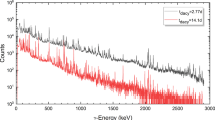Abstract
An extended Cu-target was irradiated with 22 and 44 GeV carbon ions for about 11.3 and 14.7 hours, respectively. The upper side of the target was in contact with a paraffin-block for the moderation of secondary neutrons. Small holes in the moderator were filled with either lanthanum salts or uranium oxide. The reaction\({}^{139}La(n,\gamma ){}^{140}La\mathop \to \limits^{\beta - } \) was studied via the decay of140La(40h) using radiochemical methods, as has been published. The reaction\({}^{238}U(n,\gamma )^{239} U\mathop \to \limits^{\beta - } {}^{239}Np\mathop \to \limits^{\beta - } \) was studied via the decay of239Np(2.3 d) as well as the reaction U(n,f) using radiochemical methods. In addition, solid state nuclear track detectors were used for fission studies in gold. The yields for the formation of (n,γ) products agree essentially with other experiments on extended targets carried out at the Dubna Synchrophasotron (LHE, JINR). To a first approximation, the breeding rate of (n, γ) products doubles when the carbon energy increases from 22 to 44 GeV. If, however, results at 44 GeV are compared in detail to those at 22 GeV, we observe an excess of (37±9)% in the experimentally observed239Np-breeding rate over theoretical estimations. Experiments using solid state nuclear track detectors give similar results. We present a conception for the interpretation of this fact: There is the evident connection between anomalies we observe in the yield of secondary particles in relativistic heavy ion interactions above a total energy of approximately 30–35 GeV and increased yield of neutrons in this energy region.
Similar content being viewed by others
References
Proceedings of an Information Meeting on Accelerator Breeding, upton, New York, January 1977.
R. G. VASSILKOV, V. I. GOLDANSKI, V. V. ORLOV, Usp. Phys. Nauk, 139 (1983) 435.
S. V. BAKHMUTIN et al., At. Energ., 62 (1987) 59.
Workshop on Nuclear Transmutation of Long-Lived Nuclear Power Radiowastes, Obninsk (Russia), July 1–5, 1991, Institute of Nuclear Power Engineering, Obninsk and Institute of Theoretical and Experimental Physics, Moscow. In particular the paper by V. S. BUCHENKOV et al., p. 273.
K. D. TOLSTOV, JINR Preprints 18-89-778, 1989, 18-92-303, 1992, Dubna.
V. A. VORONKO et al., At. Energ. 68 (1990), 449; 71 (1991) 563.
C. D. BOWMAN et al., Nucl. Instr. Methods Phy. Res., A320 (1992) 336 (Containing a rather extensive list of references).
F. CARMINATI et al., CERN Preprint AT/93-47 (ET), Geneva, Nov. 1, 1993.
B. BISPLINGHOFF et al., Preprint JINR, E1-93-127, Dubna, 1993; Isotopenpraxis, 30 (1994) 29.
R. BRANDT et al., Isotopenpraxis, 25 (1989) 434.
R. BRANDT et al., Phys. Rev., C45 (1992) 1194.
R. BRANDT et al., Science Intern. (Lahore), 4 (1992) 3.
R. BRANDT et al., Proc. of the IX International Seminar in High Energy Physics Problems (June 1988, Dubna), D1, 2-88-652, Vol. 2, p. 687.
R. BRANDT et al., Proc. of the X. Intern. Seminar on High Energy Physics Problems (Sept. 1990, Dubna), A. M. BALDIN (Ed.), World Scientific, Singapore, 1991, p. 405.
M. HECK, A. N. SOSNIN, Proc. XI. Intern. Seminar on High Physics Problems (Sept. 7–12, 1992, Dubna), A. M. BALDIN et al. (Eds), Dubna, JINR, 1994, p. 627.
R. BRANDT, Nucl. Tracks Radiat. Measurem., 21 (1993) 34.
R. BRANDT et al., Nucl. Tracks Radiat. Measurem., 22 (1994) 537.
W. WESTMEIER, GAMMA-W-Handbuch 1991; Nucl. Instr. Methods, A242 (1986) 437.
C. D. COLE, N. T. PORILE, Phys. Rev., C24 (1981) 2038.
See, for example E. K. HYDE, The Nuclear Properties of the Heavy Elements, Part III, Fission Phenomena, Prentice Hall, Englewood Cliffs, New Jersey, 1964, Chapter 10; A. KHODAI-JOOPARI, Ph.D. Thesis, University of California, Berkeley, 1966 (UCRL-16489).
A. POLANSKI et al., JINR Preprint E2-91-562, 1991.
Author information
Authors and Affiliations
Rights and permissions
About this article
Cite this article
Bisplinghoff, B., Bradnova, V., Brandt, R. et al. Neutron generation in massive Cu-targets during the irradiation with 22 and 44 GeV carbon ions. Journal of Radioanalytical and Nuclear Chemistry, Articles 189, 191–206 (1995). https://doi.org/10.1007/BF02042598
Received:
Issue Date:
DOI: https://doi.org/10.1007/BF02042598




